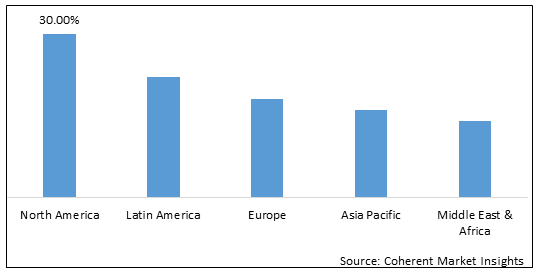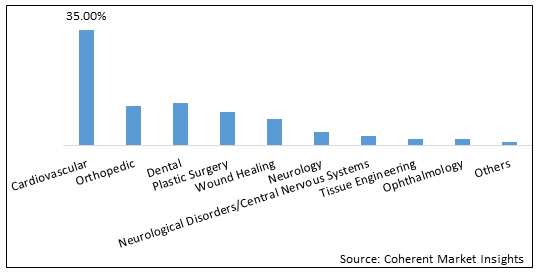Biomaterials have gained tremendous attention in tissue engineering and regenerative medicine applications attributing to their ability to enhance functional tissue regeneration. Biomaterial can be categories into natural biomaterials and synthetic biomaterials. Natural biomaterials offer various advantages over synthetic biomaterials such as they already have binding sites for cells and adhesion molecules so the biocompatibility is not a major issue. On account of advantages offered, the demand for natural biomaterials is projected to upsurge over the forecast period.
Global natural biomaterials market was valued at US$ 75.07 Billion in 2021 in terms of revenue, exhibiting a CAGR of 14.45% during the forecast period (2022 to 2030).
Drivers
Growing substantially over the forecast period, owing to rising prevalence of conditions such as osteoarthritis, rheumatoid arthritis, and sports injuries. Moreover, factors such as rising prevalence of cardiovascular diseases, increasing demand for plastics surgeries, growing cancer incidence are playing major role in fueling growth of the natural biomaterials market.
Naturally derived biomaterials is classified into many groups including polysaccharide-based biomaterials (chitin/chitosan, cellulose, glucose, etc.), protein-based biomaterials (gelatin, collagen, silk, etc.), and de-cellularized tissue-derived biomaterials (blood vessels, liver, heart valves, etc.). Natural biomaterials are preferred over synthetic biomaterials for restoring or replacing structure and for functioning of damaged tissues or organs attributing to their ability to support migration, cell adhesion, differentiation, and proliferation. The three main applications of natural biomaterials in medical are drug delivery system, tissue engineering, and wound management applications.
The COVID-19 pandemic has had a huge impact on the world's population. Rapid development of prophylactic vaccinations and patient treatment methods increased demand for innovative products. Engineered biomaterials were utilized to stimulate certain immune system responses & increase efficacy. Aesthetic operations, including breast augmentation and lipoplasty, and also non-essential dental procedures, have been delayed due to the COVID-19 outbreak. Furthermore, the pandemic had a substantial impact on the U.S., China, Japan, and European countries from March to June of 2020. The bulk of these countries are major biomaterials manufacturers, and the outbreak and global lockdowns have resulted in a drop in sales. This has a negative impact on the biomaterials industry. However, the industry recovered within the next two years as research into the development of a rapid COVID-19 detection test based on gold nanoparticles is expected to drive revenue growth of the market.
Figure 1. Global Natural Biomaterials Market Value Share (%), By Region, 2021

To learn more about this report, Download Free Sample
Market Restraints
Lack of reimbursement policies and inadequate supply of natural tissues are estimated to restrain the global natural biomaterials market growth. Difficulties relating to biocompatibility of biomaterials with living tissues are also projected to hamper the market in the near future.
Natural Biomaterials Market Report Coverage
| Report Coverage | Details | ||
|---|---|---|---|
| Base Year: | 2021 | Market Size in 2021: | US$ 75.07 Bn |
| Historical Data for: | 2017-2020 | Estimated Year: | 2022 |
| Forecast Period 2022 to 2030 CAGR: | 14.45% | Forecast Period: | 2022-2030 |
| Geographies covered: |
|
||
| Segments covered: |
|
||
| Companies covered: |
BASF SE, Biomet, Inc., Invibio Ltd., Mimetis Biomaterials, Royal DSM, Corbion N.V., Botiss Biomaterials GmbH, and Medtronic, Inc. |
||
| Growth Drivers: |
|
||
| Restraints & Challenges: |
|
||
Uncover macros and micros vetted on 75+ parameters: Get instant access to report
Market Trends
Various development in the gene therapy and medicine industries are considered as one of the major driving factors for the natural biomaterials market in terms of volume and value during the forecasted period. Advancement in technology and manufacturing process in medical industry with developed equipment in developed and emerging countries are boosting the market growth. Accumulative aged residents have been facing to several chronic diseases is another factor rushing demand in the global natural biomaterials market. Additionally, budding application of biomaterial in numerous advanced medical technologies like plastic surgery, tissue engineering, drug delivery devices, are going to open numerous opportunities for the market growth. On the other hand, use of the targeted material for tissue designing and rising cases of knee and hip replacement surgeries application is further measured as a foremost growth factor.
Figure 2. Global Natural Biomaterials Market Value Share (%), By Application, 2021

To learn more about this report, Download Free Sample
Recent Developments
Competitive Section
Major players operating in the global natural biomaterials market include BASF SE, Biomet, Inc., Invibio Ltd., Mimetis Biomaterials, Royal DSM, Corbion N.V., Botiss Biomaterials GmbH, and Medtronic, Inc.
Share
Share
About Author
Yash Doshi is a Senior Management Consultant. He has 12+ years of experience in conducting research and handling consulting projects across verticals in APAC, EMEA, and the Americas.
He brings strong acumen in helping chemical companies navigate complex challenges and identify growth opportunities. He has deep expertise across the chemicals value chain, including commodity, specialty and fine chemicals, plastics and polymers, and petrochemicals. Yash is a sought-after speaker at industry conferences and contributes to various publications on topics related commodity, specialty and fine chemicals, plastics and polymers, and petrochemicals.
Missing comfort of reading report in your local language? Find your preferred language :
Transform your Strategy with Exclusive Trending Reports :
Frequently Asked Questions
Select a License Type
Joining thousands of companies around the world committed to making the Excellent Business Solutions.
View All Our Clients